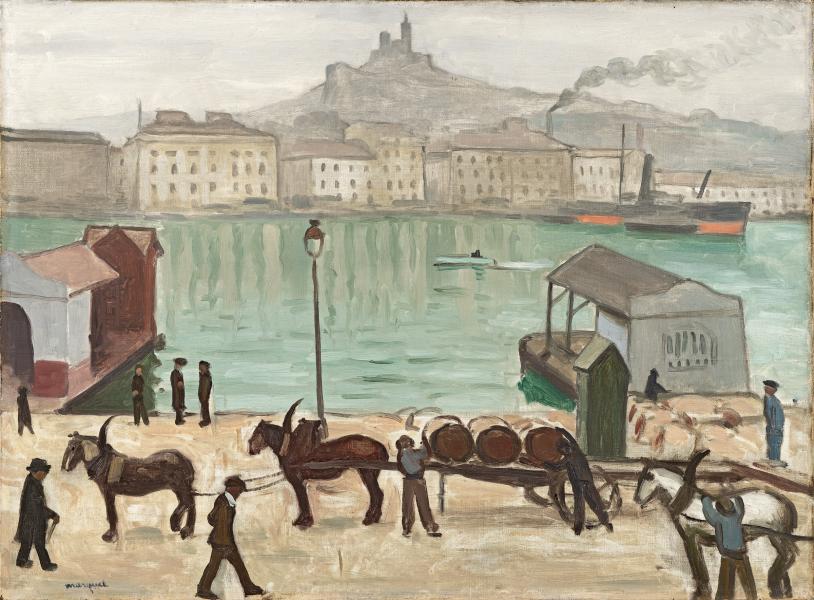Marseille, le port, Notre-Dame-de-la-Garde, 1915-1916
Oil on canvas, signed lower left.
54.02 x 73.03 cm
History:
Purchased by Druet from Marquet on February 04, 1916
Collection Mlle Marthe Dron
Collection M. Parent
Galerie Druet, Paris, 1925( n°11031)
Collection G. Descours, 1927
Galerie Schmit, Paris, 1967
Cornette de Saint-Cyr sale, Paris, June 17, 2021
Exhibitions :
Albert Marquet exhibition, Galerie Eugène Druet, Paris, November 22 - December 3, 1920, under no. 7 with the title "Marseille, Notre-Dame-de-la-Garde".
Buenos Aires, Argentina, Amigos del Arte, 1926
Utställning av modern fransk konst i Ateneum, Ateneum, Helsingfors, Finland, March 6-30, 1927, then Kunstnerforbundet, Oslo, Norway, April-May 1927, under no. 72.
La Rochelle, 1927
Exhibition Marquet, 1875 - 1947, Galerie Schmit, Paris, May 17 - June 17, 1967, reproduced in the exhibition catalog on page 55, under no. 43.
Attestation of inclusion in the artist's digital catalog raisonné issued by the Digital Catalogue Raisonné Project under the auspices of the Wildenstein Plattner Institute.
THE GHOST OF NOTRE-DAME
From his master Gustave Moreau, Albert Marquet retained, more than academic lessons, a taste for eclectic sources. It was probably thanks to him that he discovered the power of Japanese prints, unless he was drawn in by his rapacious comrades at the Bing gallery. It has to be said that the artistic Paris of his youth was steeped in Japonism, which fascinated painters in particular with its science of praising both detail and economy in a precise gesture.
and economy.
Like Manguin, Matisse and Camoin, Marquet frequented Gustave Moreau's studio between 1895 and the master's death in 1898 but because of his death, artists had to disperse to other studios. Nevertheless, the four maintained a lasting and mutual esteem and friendship. They often exhibited together, exploring, each in their own way, the springs of pictorial modernity.
Marquet's first visit to Marseille was in 1905. Having Manguin's invitation to Saint-Tropez, the delights of the Villa Demière were abandoned for a studious journey along the coast. The two artists followed the sea to Agay, where they painted with Louis Valtat and Edmond Cross. They then visited Marseille.
During the First World War, between the end of 1915 and 1918, Marquet returned to the city of Marseille, renting a studio on the Quai de Rive-Neuve overlooking the port (Eugène Montfort's studio at 15, Quai de Rive-Neuve). From this vantage point, he was able to observe the hustle and bustle of life organized around the dock and the famous transporter bridge, whose metallic stature set the pace of life in the port until it was destroyed by the Germans during the Second World War. However, the view we present is taken from the opposite quay, the Quai du Port, opening up this gap to the hill of Notre-Dame-de-la-Garde. A more enduring symbol of the city, since the monument, though degraded, would fortunately prove to be enemy-proof, the Good Mother's silhouette stands out against the sky, recognizable at first glance.
Here, however, Marquet has blended the sky and Mother in a misty hue. As the foreground builds in contrast, she appears diaphanous, a ghostly presence. At a time when the war, which was supposed to be short-lived, is getting bogged down, how can we fail to see in this a reflection of the artist's anxious times? Notre-Dame-de-la-Garde in majesty, of course, but veiled on its hillside, almost melting into the heavens. The men in the harbor, too, seem grave, striding straight ahead in their dark suits. Do they see, staring at the cobblestones of the harbor, a son, a brother mobilized at the front? A certain gravity emanates from this work, but perhaps we're extrapolating... it's only the weather, rarely gloomy in the region, that inspired the artist to create this cottony atmosphere. Contrary to the Impressionists, Marquet did not nuance his vision: instead of suggesting an atmosphere through skilful superimpositions and successive passages of color, he rejected nuance. Instead, he opts for a synthesis of tones, matching that which he applies to shapes. Chooses the dominant color perceived and sticks to it in the rendering. Sometimes underlines shapes with a black or bluish outline to delimit them firmly, contrasting the whole and making it even more explicit.
The critics of the time were a little taken aback, recognizing the success of the effect but doubting the process, fearing that the artist had traded in classical good manners of execution for ease. But this is not the case, and as the twentieth century has shown, isn't it necessary to first master one's subject perfectly before being able to synthesize and schematize it in this way? It's only by dint of observation that the eye manages to synthesize what it can communicate to the hand. On canvas, the essence of a landscape, of an atmosphere, takes shape with the gentle firmness of a Japanese print. Didn't Matisse see Marquet as a Western Hokusai? Such were his language and his signature, those of a piercing modernity, stripped of the trappings of the 19th century.

